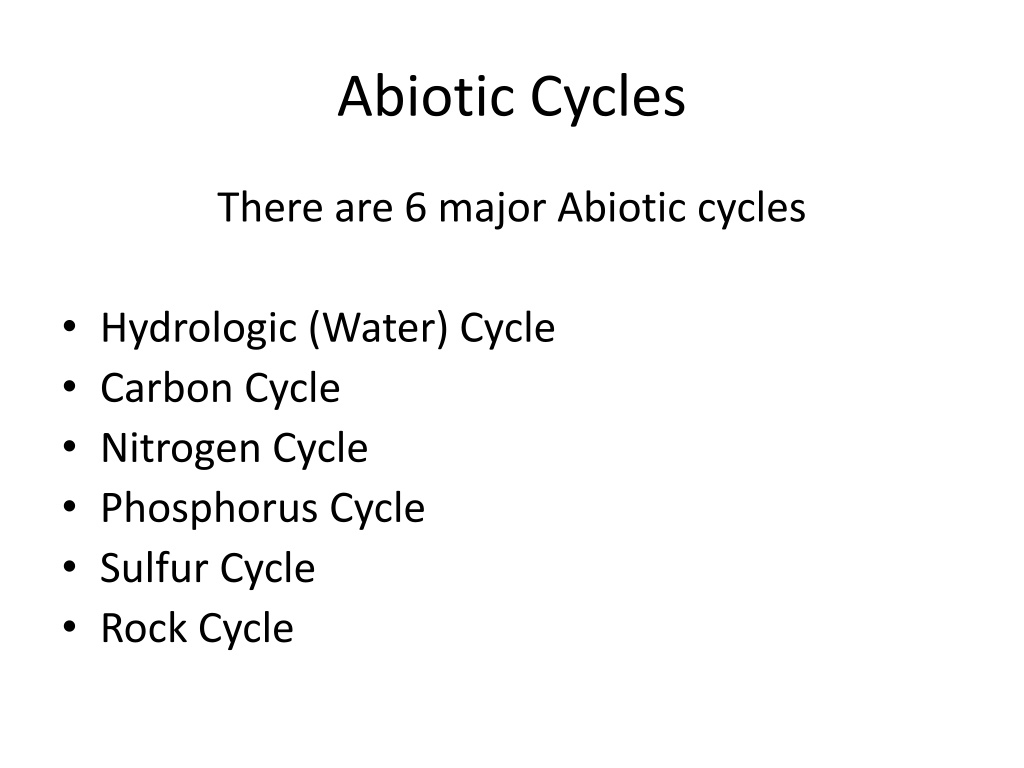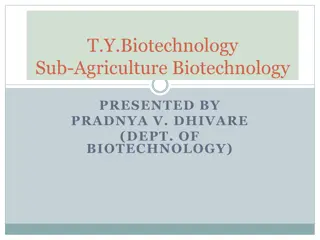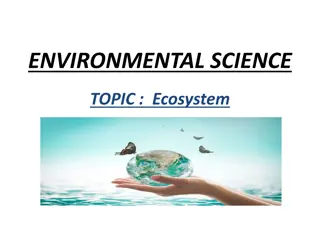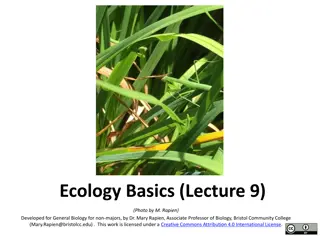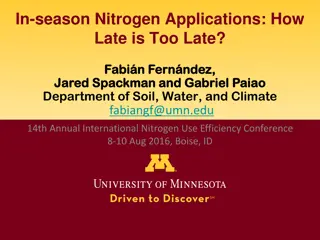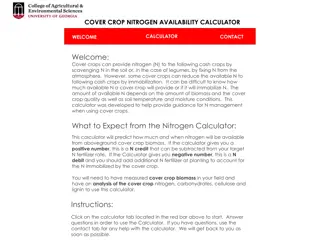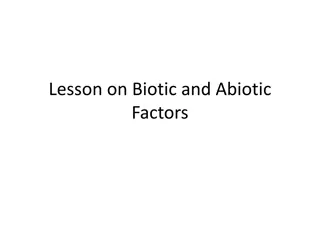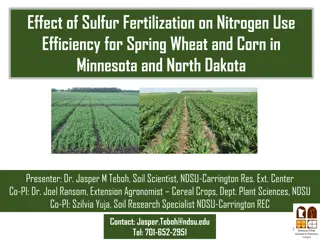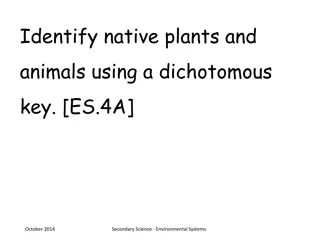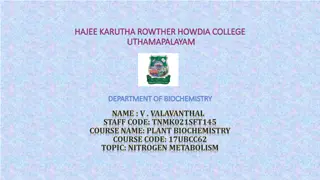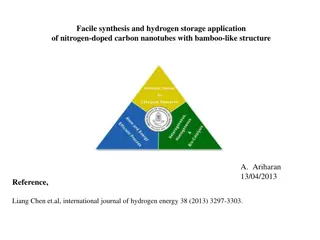Understanding Abiotic Cycles in Ecosystems: Hydrologic, Carbon, Nitrogen, and More
Abiotic cycles play a crucial role in regulating ecosystems. The hydrologic cycle involves processes like evaporation, condensation, precipitation, and transpiration. The carbon cycle relies on photosynthesis, respiration, and human activities like deforestation and burning fossil fuels. The nitrogen cycle is essential for plant growth and involves nitrogen fixation by certain bacteria. Explore the interconnectedness of these cycles and their impact on global systems.
Download Presentation

Please find below an Image/Link to download the presentation.
The content on the website is provided AS IS for your information and personal use only. It may not be sold, licensed, or shared on other websites without obtaining consent from the author. Download presentation by click this link. If you encounter any issues during the download, it is possible that the publisher has removed the file from their server.
E N D
Presentation Transcript
Abiotic Cycles There are 6 major Abiotic cycles Hydrologic (Water) Cycle Carbon Cycle Nitrogen Cycle Phosphorus Cycle Sulfur Cycle Rock Cycle
Hydrologic Cycle Condensation gaseous water molecules turning into liquid water molecules Precipitation water in the form of rain, sleet, hail, and snow that falls from the atmosphere onto land and bodies of water Infiltration/Percolation downward movement of water through soil/passage of a liquid through the spaces of a porous material such as soil. Transpiration process in which water is absorbed by the root systems of plants, moves up through the plants, passes through pores (stomata) in their leaves or other parts, and evaporates into the atmosphere as water vapor Evaporation Conversion of a liquid into a gas
Hydrologic Cycle 5 things humans do to interfere with the hydrologic cycle. Global Warming Aquifer depletion from over pumping Point source pollution Increased flooding from wetland destruction Reduced recharge of aquifers and flooding from covering land with crops and buildings
Carbon Cycle The Carbon Cycle depends on photosynthesis and aerobic respiration by the earth s living organisms. Carbon Dioxide (CO2) in the atmosphere is the major carbon contributing compound for the carbon cycle Management of the Carbon Cycle is the focus of Global Warming.
Carbon Cycle CO2enters ecosystems via photosynthesis. Respiration, deforestation, burning of fossil fuels, and forest fires are processes that put CO2up in the atmosphere. Diffusion of CO2 into aquatic systems from the atmosphere, allow carbon to get into the aquatic food webs. Here decomposition puts carbon into sediments. Compaction over time turns carbon in sediments into fossil fuels such as coal.
Nitrogen Cycle The major reservoir for nitrogen is the atmosphere. The chemically unreactive nitrogen gas (N2) makes up 78% of the volume of the atmosphere. Lightning and certain special bacteria in the roots of plants can fix nitrogen from the atmosphere. Ammonia (NH3), Ammonium (NH4+), Nitrite (NO2-), Nitrate (NO3+) are the major sources of nitrogen in the soil and aquatic systems. Burning fossil fuels, the use of fertilizers, the action of anaerobic bacteria on livestock wastes, and the destruction of forest, wetlands, and grasslands are ways humans interfere with the Nitrogen Cycle. Natural processes like volcanic activity can also put Nitrogen Oxides in the atmosphere.
Nitrogen Cycle Nitrogen Fixation combining N2gas with H to make NH3 which some is converted into NH4+ Ammonification conversion of detritus into simpler N containing inorganic compounds NH3and NH4+ Nitrification a two step process where special bacteria convert NH3and NH4+into NO2-and NO3-for use by plants. Denitrification conversion of NH4+and NH3back into NO2-and NO3-and then into N2and N2O which releases to the atmosphere
Phosphorus Cycle The major reservoir for phosphorus is phosphate salts containing phosphate ions (PO43-), in terrestrial rock formations and ocean bottom sediments. Phosphorus Cycle is slow compared to the water, carbon, and nitrogen cycles. Phosphorus is transferred by food webs. It is a component of nucleic acids, ADP, ATP, bones and teeth. Phosphorus is often the limiting factor for plant growth, unless it is applied as fertilizer. It is also the limiting growth factor for producer populations in freshwater streams and lakes because it is only slightly soluble in water.
Phosphorus Cycle Humans interfere with Phosphorus Cycle by extensive mining of phosphate salts, heavy use of fertilizer, and poor management of sewage. Erosion and Runoff are the major transportation means of phosphates into aquatic systems.
Sulfur Cycle Most of the sulfur on earth is stored in rocks and minerals including sulfate salts (SO42-) buried deep under ocean sediments. Sulfur also enters the atmosphere by anaerobic decomposers producing hydrogen sulfide (H2S), and volcanic activities releasing sulfur dioxide (SO2) Sulfur particles such as ammonium sulfate enter the atmosphere from sea spray, dust storms, and forest fires Sulfate ions are an essential component of many proteins Humans interfere with the sulfur cycle by burning and refining fossil fuels, burning coal, and smelting metals which release Sulfur Dioxide into the atmosphere.
Sulfur Cycle (DMS) Dimethyl sulfide (CH3SCH3) tiny particles of this compound serve as condensation nuclei for water droplets to form clouds. DMS is also converted into sulfur dioxide in which some turns into sulfur trioxide, in which tiny droplets of sulfuric acid can form. DMS can react with atmospheric chemicals such as ammonia to produce tiny particles of sulfate salts. These droplets and particles then fall to the earth as acid rain, or acid deposition. In oxygen-deficient environments specialized bacteria convert sulfate ions (SO42-) sulfide ions (S2-). These sulfide ions react with metal ions to form insoluble metallic sulfides which become deposited as rock allowing the cycle to continue.
Rock Cycle The slowest of earth s cyclic processes The earth s crust consists of mostly minerals and rocks. Most of the more than 2000 identified minerals occur as inorganic compounds formed by various combinations of elements. Mineral an element or inorganic compound that occurs naturally in the earth s crust as a solid with a regular internal crystalline structure. Rock a solid combination of one or more minerals found in the earth s crust.
Rock Cycle Three major types of Rock Sedimentary Rock made of sediments, dead plant and animal remains and existing rock that are weathered or eroded into tiny particles. (EX. Sandstone, Shale, Dolomite, Limestone, Lignite, Bituminous Coal) Igneous Rock made of liquid magma that wells up from the upper mantle or deep crust, then cools and hardens. Form the bulk of the earth s crust. (EX. Granite and Lava Rock) Metamorphic Rock when preexisting rock is subjected to high pressure and temperatures, chemically active fluids, or a combination of all three. These forces change the physical properties, appearance, and reshape the crystalline structure. (EX. Anthracite, Slate, Marble)
VIDEOS Role of Abiotic Factors Carbon Cycle Nitrogen Cycle Phosphorus Cycle Sulfur Cycle
